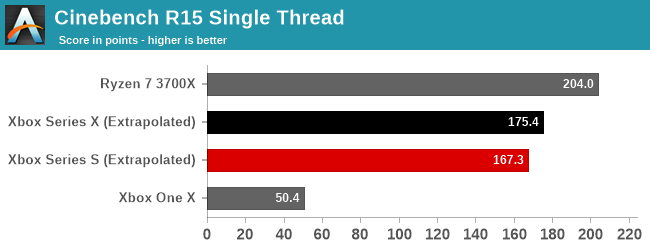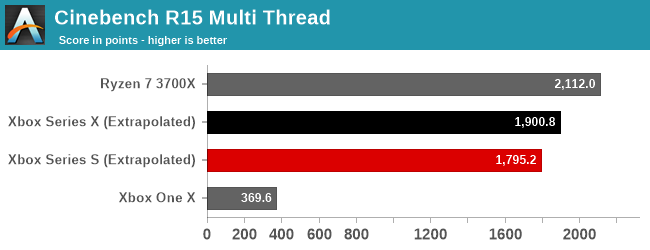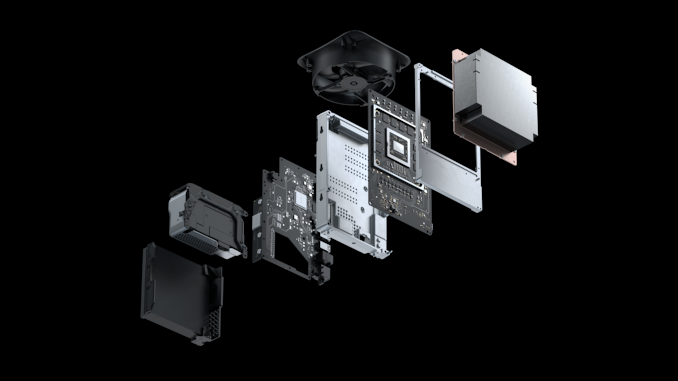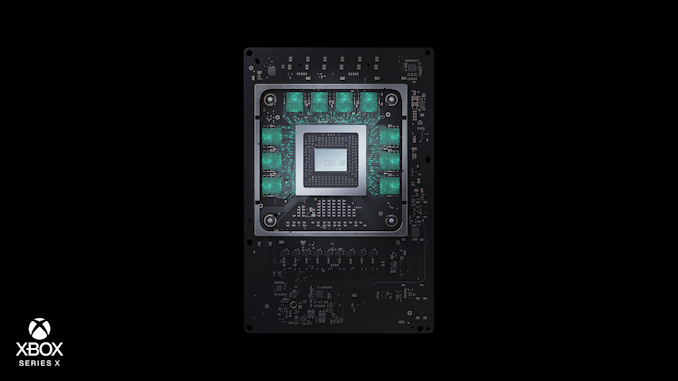The Xbox Series X Review: Ushering In The Next Generation of Game Consoles
by Brett Howse on November 5, 2020 9:00 AM ESTPowering Xbox: All AMD
Anyone watching the PC space should be aware of how far AMD has come in the last couple of years. First with the launch of their Zen CPU architecture, and again with Zen 2 and Zen 3, AMD has shot back up to being a formidable opponent for Intel. On the graphics side, AMD has trailed market leader NVIDIA for some time, although they are trying to make amends with their new RDNA 2 graphics architecture. Throughout all of this, AMD has been a staple in the console space, providing the system on a chip (SoC) powering both PlayStation and Xbox in the last generation, and AMD’s design wins have continued for this new generation.
Harnessing Zen 2
The big difference for this generation of console is just how far AMD has come with their CPU architecture. The Xbox One and its various revisions were powered eight AMD Jaguar CPU cores, at 1.75 GHz in the Xbox One and One S, and 2.3 GHz in the One X. Originally designed for small, low-power (and low-cost) systems, Jaguar was not the best CPU architecture when it launched. And following the years since then serving as the heart of the last generation of consoles, Jaguar is definitely feeling the pinch in 2020.
For the Xbox Series X|S lineup, Microsoft is again turning to AMD, and this time AMD is ready and waiting for Microsoft with their much more powerful Zen 2 CPU cores. In the case of the Xbox Series X, it is offering eight cores which will run at 3.8 GHz sustained on eight threads, or if the developer chooses to leverage Simultaneous Multithreading (SMT) and run sixteen threads, the processor will run at 3.6 GHz sustained. The lower-powered Series S offers the same number of cores, but at 3.6 GHz / 3.4 GHz instead. Some may wonder why they do not match the 4 GHz+ frequencies of the desktop counterparts, but consoles are more about consistent experiences than peak performance for a short time, so there is no turbo function in the Xbox.
To highlight just how great the difference in performance is between the old Jaguar cores and AMD's Zen 2 cores, we'll start with a quick look at Cinebnech R15. We have been lucky enough to actually benchmark the Xbox One SoC, with eight Jaguar cores running at 2.3 GHz, matching the CPU frequency of the Xbox One X. Unfortunately, there is no exact replica of a Zen 2 processor to compare, but the Ryzen 7 3700X we tested offers the same eight cores and sixteen threads, although with a 4.4 GHz turbo frequency. So we'll go ahead and extrapolate from the score for AMD's Ryzen 7 3700X CPU to account for the slower clockspeeds of the new Xboxes,


XSX/XSS: Performance Extrapolated From R7 3700X
Even adjusted to somewhat match the lower clockspeeds of the new consoles, the raw performance from the new Zen 2 processor in the Series X is significantly higher than the outgoing Xbox One X. Under Cinebench R15, single-threaded performance is an impressive 248% faster in the Series X, and 232% in the Series S. With up to 16 threads available on the new consoles, multithreaded performance offers an even larger benefit, at 414% faster in the Series X, and 386% faster in the Series S.
The previous generation consoles were significantly CPU limited, and while this was not always noticeable in gameplay, the new generation should be able to offer much more immersive scenes with more going on at any one time thanks to the major CPU performance increase – even on Series S.
Powered by RDNA 2
Of course, a major part of any console is the graphics processing unit. And even more so than on the CPU side, Microsoft's choice of architecture for the GPU side of their console SoCs is on the absolute cutting edge thanks to AMD's RDNA 2 architecture. In fact, at launch, the Xbox Series X will have a more modern AMD GPU than is available in any PC since AMD is not releasing RDNA 2 to the PC until 8 days after the console launch. RDNA 2 brings about some major upgrades to AMD’s GPU lineup which the Xbox team will leverage to get the most out of the new hardware.
One of the biggest changes is the inclusion of hardware support for ray tracing, and as Microsoft has implemented DirectX Ray Tracing (DXR) support, the hardware and software will finally be available in a console for developers to leverage ray tracing for scene lighting. It will no doubt come at a performance penalty, as it is still a massively complex and computationally expensive task to use ray tracing for lighting, but for games that can handle the performance loss, the quality of the lighting, reflections, and other effects should increase tremendously.
Not to be outdone, shaders have also seen some tremendous improvements with this generation, and the Xbox is taking advantage of all the improvements. Mesh shaders allow highly complex scenes to be rendered by having threads cooperate, so thousands of geometric objects can be shaded from a relatively low number of shaders. Imagine a beach where every grain of sand needs to be rendered. Since most of the grains of sand are similar, mesh shading allows for a significant amount of replication to be avoided, without taking away from the overall image quality. There is a lot more to mesh shaders than just this example, and they will require new game engines to take advantage of the new shader processes, but we should start to see this in next-gen titles in the future.
RDNA 2 also brings Variable Rate Shading (VRS) to the table, which allows developers to concentrate their resources where it is important. In any one scene, not all of the image display is going to be noticed, so VRS allows the developer to focus the performance and image quality on the parts of the scene that are the most important by reducing the shading quality in those unimportant areas. This allows for higher frame rates, ideally without a noticeable impact on visuals. We are seeing this already implemented at launch in games optimixed for the X|S lineup, such as Gears 5.
Adding to the new hardware features is the varying sizes of the integrated GPUs inside of the Xbox Series X|S. On the CPU side, the consoles are similar in hardware, but on the GPU and other fronts, the Series S and Series X most definitely diverge. The GPU is certainly one of the most obvious changes here, as Microsoft has outfitted the Series X with a beefy 12 TFLOP GPU, with 52 CUs, and a 1.825 GHz frequency. This is slightly smaller than the Radeon RX 6800 announced at the end of October but still double the TFLOPS of the Xbox One X (and more efficient on top of that). The Series S is a much smaller GPU, with 20 CUs, 1.565 GHz frequency, and 4 TFLOPS total.
GDDR6 Memory
A critical feature of any console is the memory, and not only how much in total, but how much is available to developers and how fast it is as well. Here the Series X and Series S diverge significantly again, with the X clearly focused on maximizing performance to drive a 4K resolution, and the S clearly focused on price.
Both consoles feature GDDR6 memory, with 16 GB in the Xbox Series X, and 10 GB in the Xbox Series S. Thanks to improvements in the dashboard design, Microsoft has lowered the system reserved memory to just 2.5 GB on the Series X, and 2 GB on the Series S, meaning the consoles have 13.5 GB and 8 GB of developer-accessible memory respectively.
The Xbox Series X offers a 320-bit wide system bus, which is actually a bit narrower than the outgoing Xbox One X, which had a 384-bit wide bus. But, thanks to GDDR6, the bandwidth is simultaniously both slightly better and much better. Which seems like an odd thing to say, but the Xbox Series X does not offer a uniform memory interface; instead there are different channels of memory addressing different amounts of memory by virtue of using different GDDR6 chip sizes (either 8 Gbit or 16 Gbit). This results in an asymmetrical maximum bandwidth, with 10 GB of the memory available at up to 560 GB/s, and 6 GB of the memory available at 336 GB/s. The Xbox One X, in comparison, offered 324 GB/s across its entire memory space. The higher-bandwidth portion is completely free for developers, with the Xbox system reserved memory living on the slower 6 GB, leaving 3.5 GB of it available for developers.
The memory situation on the Series S is much different though. This system, to save cost, and due to its lower performance target, has just a 128-bit wide bus, and while it still offers an asymmetrical memory layout, all 8 GB of developer reserved memory is available at one speed, which is 224 GB/s. The 2 GB of system-reserved memory is just 56 GB/s, but that should be plenty for the dashboard.












68 Comments
View All Comments
edzieba - Thursday, November 5, 2020 - link
I think the weirdest thing about this console generation is the near total lack of enthusiasm, either organic or marketed.I haven't seen a single advert for either console, this is the first I've heard that one of them is available, and couldn't tell you when the PS5 will be launching either. Nobody I know is in the "yeah, new <Console>! I'm gonna get it so I can play <Game>!", and can't think off he top of my head of any of the launch titles for either (again, no adverts).
Stuka87 - Thursday, November 5, 2020 - link
I have seen tons of buzz online. But you are right that I have not seen a single commercial for them. And the video commercials I have seen, all mention the XBox One. Definitely very different than the last time new consoles launched.nitram_tpr - Thursday, November 5, 2020 - link
I saw my first ad for the XBox Series X yesterday on UK TV, it looked impressive but it wasn't a really hyped up advert. Not like the ads for the new iphone (the most powerful iphone ever, well duh, it's new!)dmoros78v| - Monday, November 9, 2020 - link
phones have gotten ridiculous as of late, and we are guilty... we cry foul when a new console costs more than 500 bucks, but are happy to pay 1000 for a phone? iphone prices have become really distorted, the hardware on an iphone cant be twice as expensive a the hardware in a fully fledged gaming console for 4K HDR ray tracing etcstar-affinity - Tuesday, November 10, 2020 - link
I think you are comparing apples to oranges here. Saying that a phone is expensive compared to a gaming console isn't fair since there are quite a lot of more complex technology in a (modern) phone which can do *a lot* more than play/stream games and play/stream media.A (flagship) phone has
-Camera (multiple) built-in.
-Face recognition.
-Multi-touch display built-in.
-Speakers built-in.
-GPS built-in.
-Gyro built-in.
-NFC built-in.
-Battery built-in.
Plus many more things in a tiny packages which requires a lot of R&D.
By your reasoning, how do you motivate a graphics card for $2700?
d0x360 - Wednesday, November 18, 2020 - link
The bill of materials on a phone is 1/4 their price. What you're paying for is the short sales shelf life and r&d. My note 10+ was NOT worth $1200+. I liked my note 9 much better and it was $600 cheaper.How do you justify a $2700 gpu? You don't because the most expensive one is only $1500. If you're paying ebay prices for one then you're a fool. Wait until after December and save yourself money.
dotjaz - Tuesday, November 10, 2020 - link
Mobility carries a premium, that's the name of the game. Plus phone companies can't profit after they sold you the phone while consoles can be sold at a loss and still viable.How dumb are you to compare those? A fair comparison is a ohone on contract! And they are still cheap.
dotjaz - Tuesday, November 10, 2020 - link
*phoned0x360 - Wednesday, November 18, 2020 - link
Yea they can profit, who are you kidding. They have apps and services that they use to sell information. They make way more than the cost of the phone back off ever owner..unless they use adguard. Adguard.com version, not the fake one in the play store or ios store.wrongfuljesus - Wednesday, February 10, 2021 - link
Well buckaroo, tell me, is your battery life dying? Is your phone on it's last legs in 6 months of usage? Well, the phone company is here tell *YOU* that you can come to their repair shop for a good and "safe" repair! For the low price of your self dignity and your yearly salary, you can pay to get your battery replaced. Boom, company profit buddy. Serializing parts, can't repair on your own. Tell me now, tell me, how is the phone company NOT profiting after they sold you this device?